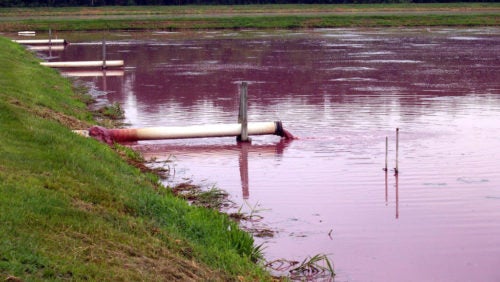Too Big on the Pig: America’s Taste for Pork Comes with Costs
March 18, 2019 by Catherine Schluter

Polluted Lagoon
Pork is a big part of the American diet, but pig farming has serious environmental and human health consequences. North Carolina is one of the biggest pork producers in the country, but its state legislature, like many other states, is putting pork profits over sufficient protections.
Many Americans have enjoyed a couple of slices of bacon at brunch, a ham at Christmas, or a hot dog at a baseball game. Pork is a big business – it provides the US with a total gross income of more than $20 billion a year[1], and in 2018 it was projected to equal or surpass beef production for the first time in history.[2] Sales are up 20% since 2011,[3]due in part to the use of pork in trendy Korean, Vietnamese, and Latino cooking, the growing popularity of bacon, and the Pork Board’s clever advertising campaign declaring pork “the other white meat.”[4]However, increased pork consumption comes at the cost of exacerbating environmental harms caused by massive pork farming operations,[5] and state regulators have failed to take appropriate steps to enforce the law and protect the environment and their citizens.
The biggest problem is dealing with waste – one pig creates approximately 11 pounds of waste per day.[6] The pork industry operates using concentrated animal feeding operations (“CAFOs”), which can house thousands of livestock animals. In swine CAFOS, waste is mixed with water and collected in an open pit called a lagoon.[7]The lagoons appear bright pink from bacteria that consumes the sulfur compounds within the waste,[8]and neighbors must suffer “olfactory torture” due to the stench.[9]The toxic mixture also has serious human health risks when ingested, including high risks of cancer, miscarriages, and infectious diseases.[10]Although newer lagoons are lined in clay, old ones are not lined and allow contaminants such as heavy metals, salmonella, and other pathogens to seep into the ground.[11]
To prevent the lagoons from overflowing, the waste can also be aerially sprayed over fields as fertilizer, which washes into the watershed causing algae blooms and fish kills due to the excess phosphorus and nitrogen.[12]Additionally, because they are uncovered, the lagoons are susceptible to flooding. For example, during Hurricane Florence in 2018, 50 lagoons overflowed in North Carolina, which has the second largest hog operation in the nation, allowing millions of gallons of untreated swine feces into flood waters and surrounding waterways.[13]Although treating the waste water, covering the lagoons, or eliminating aerial spraying are viable options to better control the dangerous waste, the pork industry claims it is too expensive and industry-friendly state politicians are unwilling to tighten regulations.[14]
State governments play a large and varying role in how freely CAFOS operate. In Missouri, the state attorney general recently sued CAFOs to force them to adopt technology that reduces odors and threats to water quality.[15] In North Carolina, however, state government has not shown the same concern for environmental and human health. In 2017, the North Carolina state legislature overrode a gubernatorial veto to limit the liability of hog farms in future nuisance lawsuits.[16]State inspectors are underfunded, with the worst region employing only 3 inspectors for 731 swine operations.[17]Additionally, inspections occur only yearly unless otherwise prompted by complaints, and they can last as few as 45 minutes instead of the recommended two to four hours.[18]Lax regulation can also allow sludge to build up in lagoons and allow the liquid manure aerially sprayed to drift far from the fields it is sprayed on, including into nearby waterways.[19]Many state politicians are committed to encouraging the jobs and tax income big pork provides without considering the damaging health and environmental effects, and it seems unlikely that stricter regulations will be promulgated until state politicians recognize the deleterious effects pork CAFOs have on their citizens.
[1] National Pork Producer’s Council, Pork Facts, http://nppc.org/pork-facts/ (last visited Mar. 6, 2019).
[2] Caitlin Dewey, Why Americans are eating more pork now than they have in decades, Washington Post, (May 26, 2017), https://www.washingtonpost.com/news/wonk/wp/2017/05/26/why-americans-are-eating-more-pork-now-than-they-have-in-decades/?utm_term=.ed2e7b6c7936.
[3] Id.
[4] Id.
[5] U.S. Dep’t of Agric., Animal Feeding Operations, https://www.nrcs.usda.gov/wps/portal/nrcs/main/national/plantsanimals/livestock/afo/.
[6] Beth Hoffman, What the Pork? China, Pigs, and Poop, Forbes, (May 13, 2014), https://www.forbes.com/sites/bethhoffman/2014/05/13/what-the-pork-china-pigs-and-poop/.
[7] Wynne Davis, Overflowing Hog Lagoons Raise Environmental Concerns in North Carolina, NPR, (Sept. 22, 2018), https://www.npr.org/2018/09/22/650698240/hurricane-s-aftermath-floods-hog-lagoons-in-north-carolina.
[8] Id.
[9] Ned Barnett, N.C. hog industry gets a whiff of odor’s cost – $50 million. Will it clean up now?, The News & Observer (Raleigh, NC), May 1, 2018, https://www.newsobserver.com/opinion/article210207404.html.
[10] Emily Moon, North Carolina’s Hog Waste Problem has a Long History. Why Wasn’t It Solved in Time for Hurricane Florence?, Pacific Standard, (Sept. 14, 2018), https://psmag.com/environment/why-wasnt-north-carolinas-hog-waste-problem-solved-before-hurricane-florence.
[11] Id.
[12] Id.
[13] Hoffman, supra note 6.
[14] Barnett, supra note 9; Moon, supra note 10.
[15] Barnett, supra note 9.
[16] Katelin Shugart-Schmidt, North Carolina Legislature Limits Nuisance Lawsuits, Reducing Potential Liability for Hog Farming Industry, Lexology, (Sept. 8, 2017), https://www.lexology.com/library/detail.aspx?g=2c46a2fb-cc87-493a-a25b-9180f041d45e.
[17] Alex Formuzis, Court Documents Reveal Woefully Lax Inspections of NC Factory Farms, Environmental Working Group, (Dec. 13, 2018), https://www.ewg.org/release/court-documents-reveal-woefully-lax-inspections-nc-factory-farms.
[18] Id.
[19] Id.

